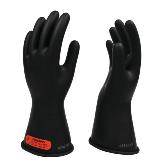
Electric vehicles (EV) and hybrid vehicles (HV) store energy in battery packs that charge and discharge direct current (DC). Although the individual battery power cells are low voltage, they are connected in series to achieve a total system voltage of 200 – 900 volts DC. Charging systems for EV and HV can be either DC for direct charging or AC (alternating current) which is then converted to DC to charge the battery. The motors powering EV and HV run on AC, so the DC energy stored in the batteries is converted to AC to power the motors.
Hazards and Risks Servicing Electric and Hybrid Vehicles
With system voltage 16 – 75 times higher than conventional vehicle 12 volt systems, the risks increase as well. Quite often technicians servicing conventional vehicles can and will disconnect the battery. But for electric and hybrid vehicles, that may not be practical or possible. Therefore, service technicians need to be protected with suitable and appropriate insulating products.
Rubber Insulating Gloves for EV and HV Service

Hands are usually the first point of contact with potentially energized systems, so rubber insulating gloves are the first line of protection for the service technician. Rubber insulating gloves sold in North America comply with
ASTM Standard Specification D120 which includes ratings, test voltages and maximum working voltages for both AC and DC systems. Gloves sold in other markets may comply with international standard EN60903 which also includes AC and DC requirements. Since EV and HV power systems are DC, users should focus on the DC maximum working voltage. ASTM D120 class 00 gloves are proof tested at 10,000 volts DC with a maximum working voltage of 750 volts DC.
The EV market is projected to shift towards 800 volt DC systems within the next few years, so service technicians should consider stepping up to class 0 rubber insulating gloves with a maximum working voltage of 1,500 volts DC. Regulations and specifications require that protector gloves, usually of leather, be worn over rubber insulating gloves.
Testing and Recertification of Rubber Insulating Gloves
 OSHA regulations
OSHA regulations enforce the
ASTM F496 specification for in-service use of rubber insulating gloves which require retesting of insulating gloves at least every 6 months. It is most common to test and retest insulating gloves at AC voltage levels since that replicates the power systems throughout the country. But, with the understanding of testing gloves as they are to be used, DC testing is most appropriate for insulating gloves used for servicing EV and HV power systems.
Additional PPE for EV and HV Service
While insulating gloves are the first line of protection, service technicians should use insulating hand tools and wear an apron made from insulating material. Other protective apparel includes arc flash faceshields and coveralls.
Daily Work Practices
As always, personal protective equipment should be inspected at the start of every work shift and immediately after any event that may cause damage to the product and reduce safety.
Connect with Saf-T-Gard to Learn More
Industrial safety is our legacy going back 9 decades. For an overview of our specialized products and services for automotive safety, please visit
Automotive Safety.
Go back to blog listing

 Electric vehicles (EV) and hybrid vehicles (HV) store energy in battery packs that charge and discharge direct current (DC). Although the individual battery power cells are low voltage, they are connected in series to achieve a total system voltage of 200 – 900 volts DC. Charging systems for EV and HV can be either DC for direct charging or AC (alternating current) which is then converted to DC to charge the battery. The motors powering EV and HV run on AC, so the DC energy stored in the batteries is converted to AC to power the motors.
Electric vehicles (EV) and hybrid vehicles (HV) store energy in battery packs that charge and discharge direct current (DC). Although the individual battery power cells are low voltage, they are connected in series to achieve a total system voltage of 200 – 900 volts DC. Charging systems for EV and HV can be either DC for direct charging or AC (alternating current) which is then converted to DC to charge the battery. The motors powering EV and HV run on AC, so the DC energy stored in the batteries is converted to AC to power the motors. Hands are usually the first point of contact with potentially energized systems, so rubber insulating gloves are the first line of protection for the service technician. Rubber insulating gloves sold in North America comply with ASTM Standard Specification D120 which includes ratings, test voltages and maximum working voltages for both AC and DC systems. Gloves sold in other markets may comply with international standard EN60903 which also includes AC and DC requirements. Since EV and HV power systems are DC, users should focus on the DC maximum working voltage. ASTM D120 class 00 gloves are proof tested at 10,000 volts DC with a maximum working voltage of 750 volts DC. The EV market is projected to shift towards 800 volt DC systems within the next few years, so service technicians should consider stepping up to class 0 rubber insulating gloves with a maximum working voltage of 1,500 volts DC. Regulations and specifications require that protector gloves, usually of leather, be worn over rubber insulating gloves.
Hands are usually the first point of contact with potentially energized systems, so rubber insulating gloves are the first line of protection for the service technician. Rubber insulating gloves sold in North America comply with ASTM Standard Specification D120 which includes ratings, test voltages and maximum working voltages for both AC and DC systems. Gloves sold in other markets may comply with international standard EN60903 which also includes AC and DC requirements. Since EV and HV power systems are DC, users should focus on the DC maximum working voltage. ASTM D120 class 00 gloves are proof tested at 10,000 volts DC with a maximum working voltage of 750 volts DC. The EV market is projected to shift towards 800 volt DC systems within the next few years, so service technicians should consider stepping up to class 0 rubber insulating gloves with a maximum working voltage of 1,500 volts DC. Regulations and specifications require that protector gloves, usually of leather, be worn over rubber insulating gloves. OSHA regulations enforce the ASTM F496 specification for in-service use of rubber insulating gloves which require retesting of insulating gloves at least every 6 months. It is most common to test and retest insulating gloves at AC voltage levels since that replicates the power systems throughout the country. But, with the understanding of testing gloves as they are to be used, DC testing is most appropriate for insulating gloves used for servicing EV and HV power systems.
OSHA regulations enforce the ASTM F496 specification for in-service use of rubber insulating gloves which require retesting of insulating gloves at least every 6 months. It is most common to test and retest insulating gloves at AC voltage levels since that replicates the power systems throughout the country. But, with the understanding of testing gloves as they are to be used, DC testing is most appropriate for insulating gloves used for servicing EV and HV power systems.
